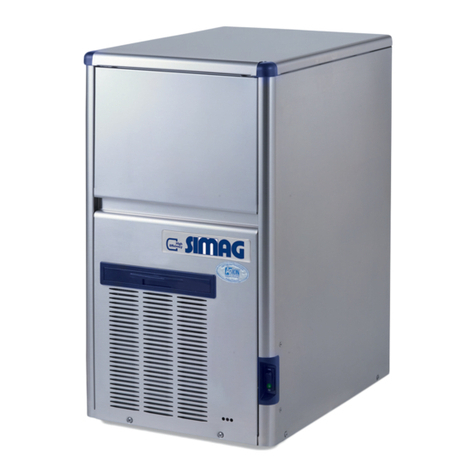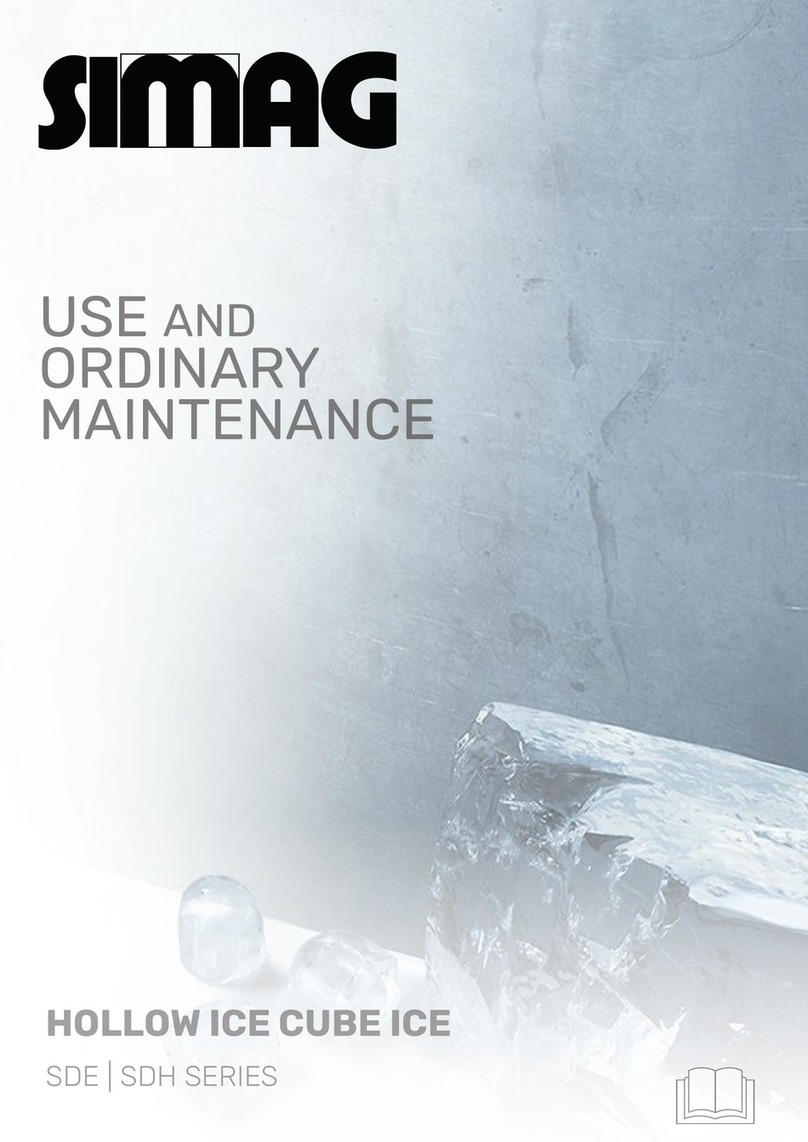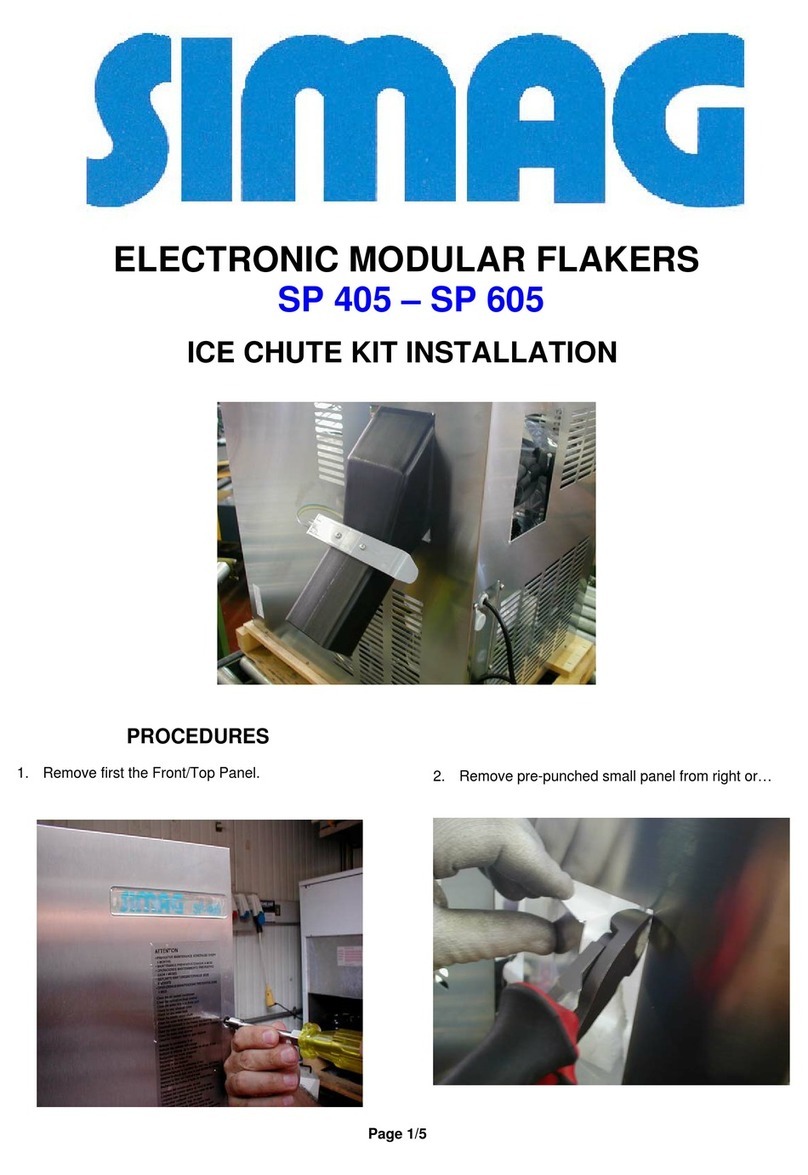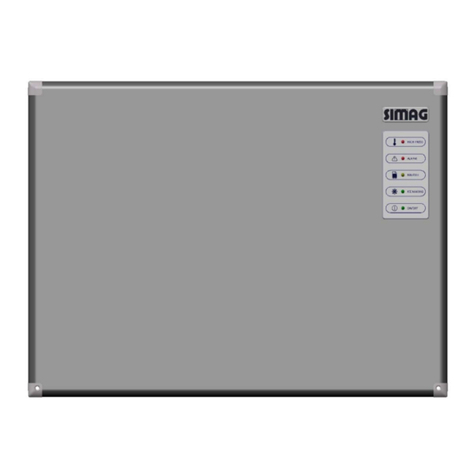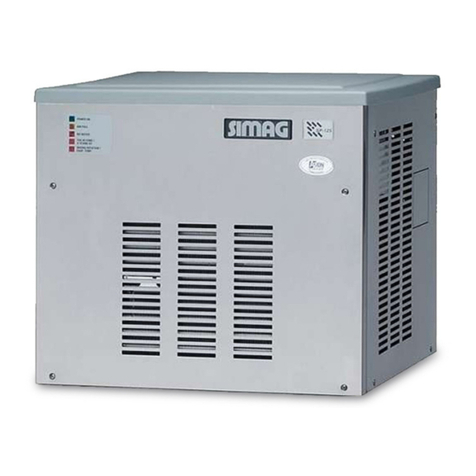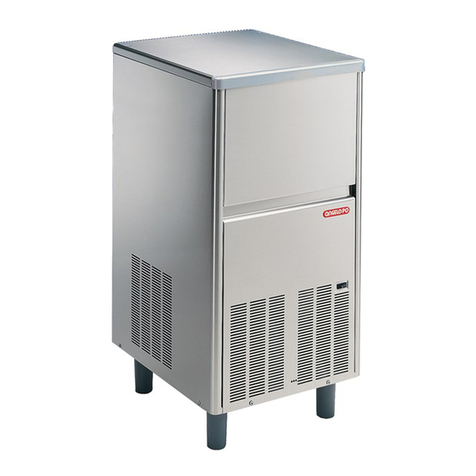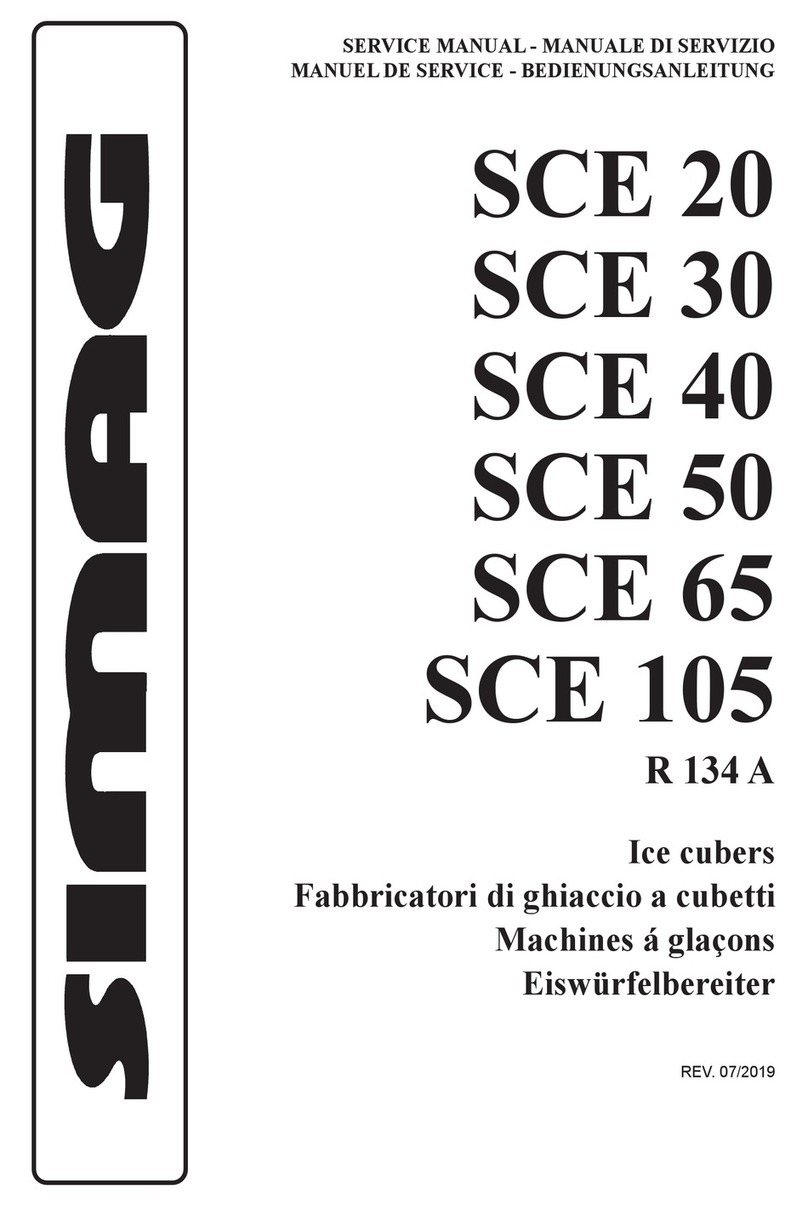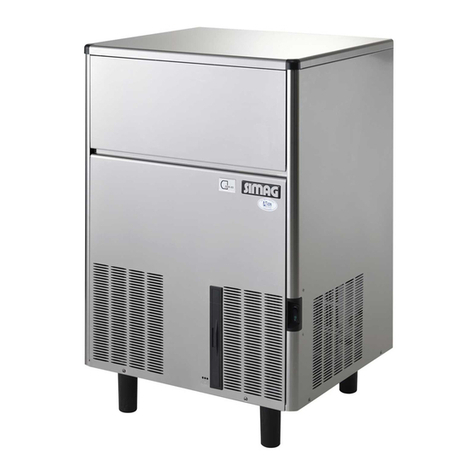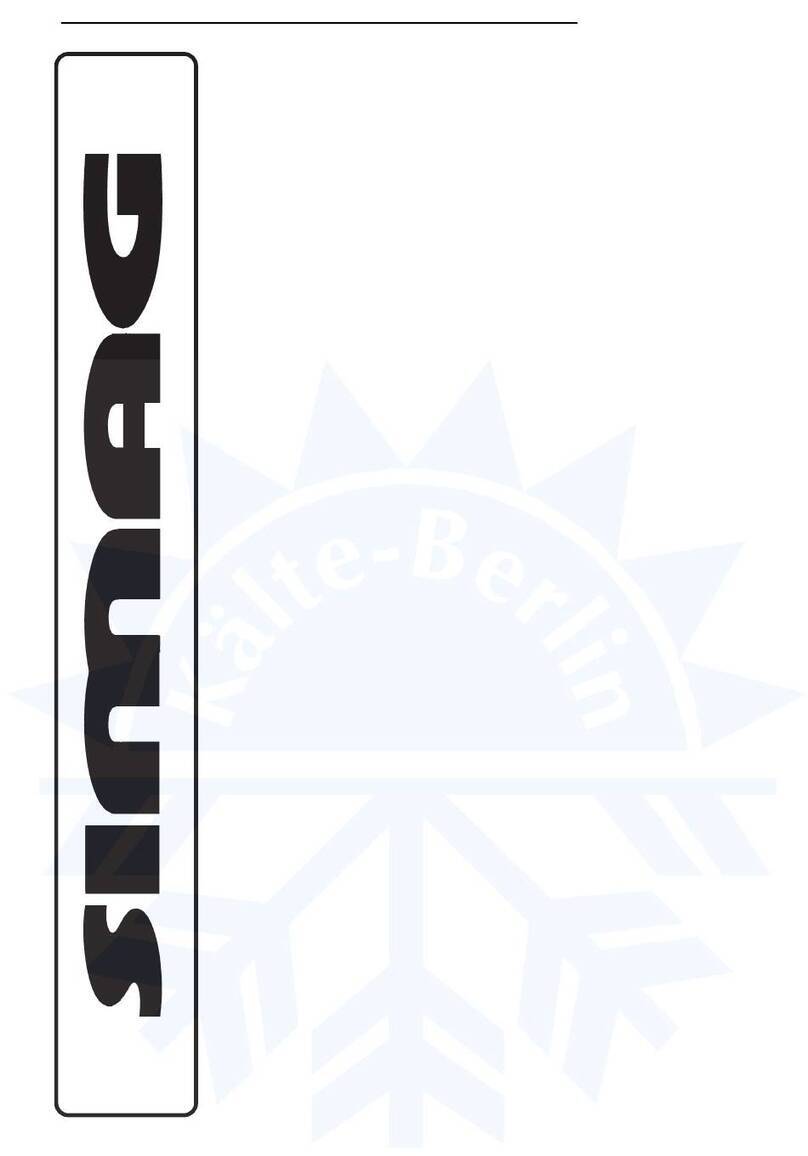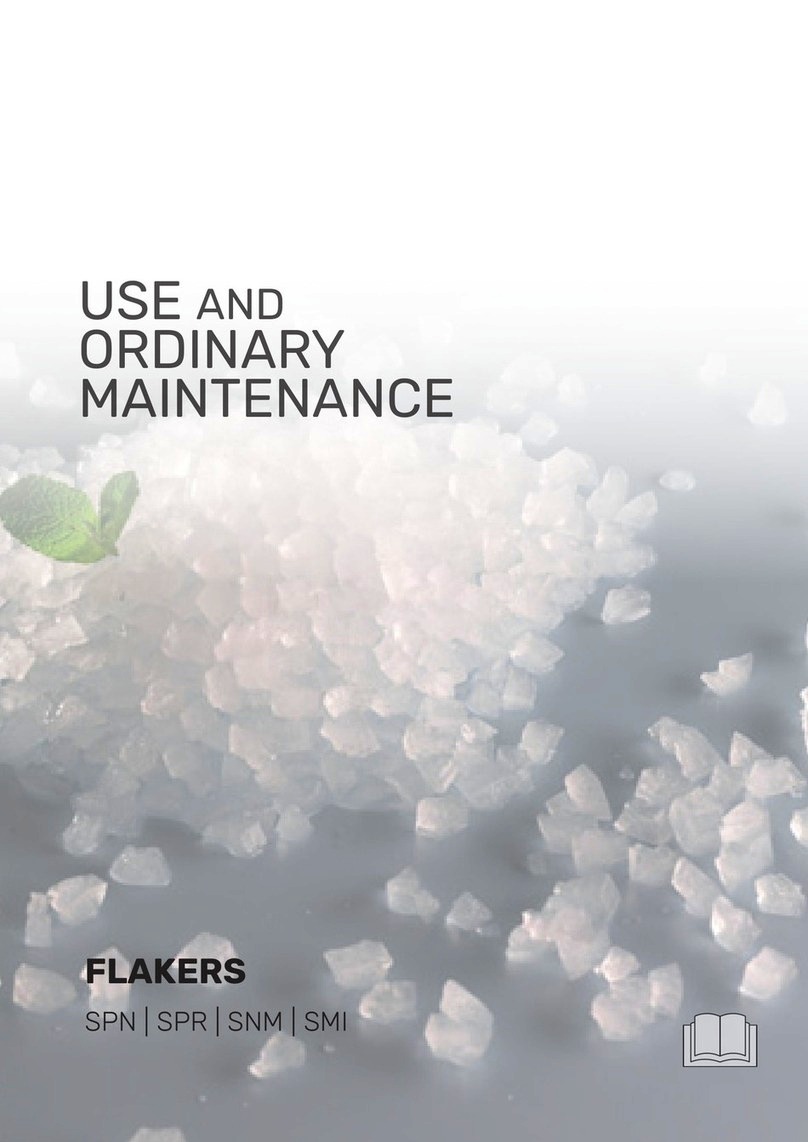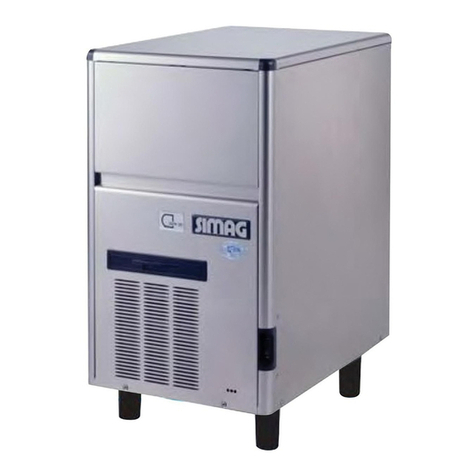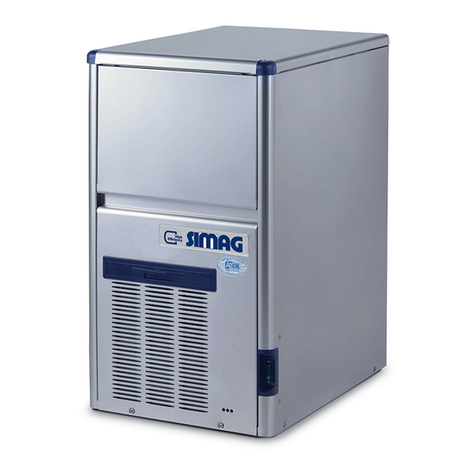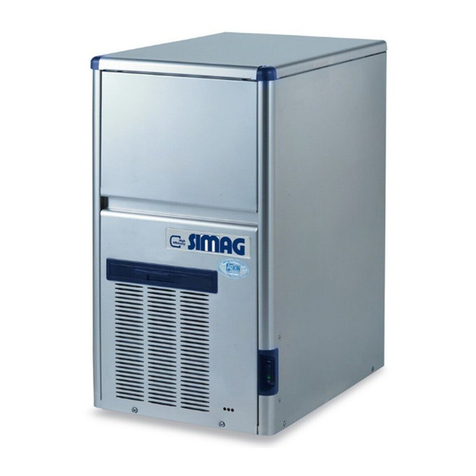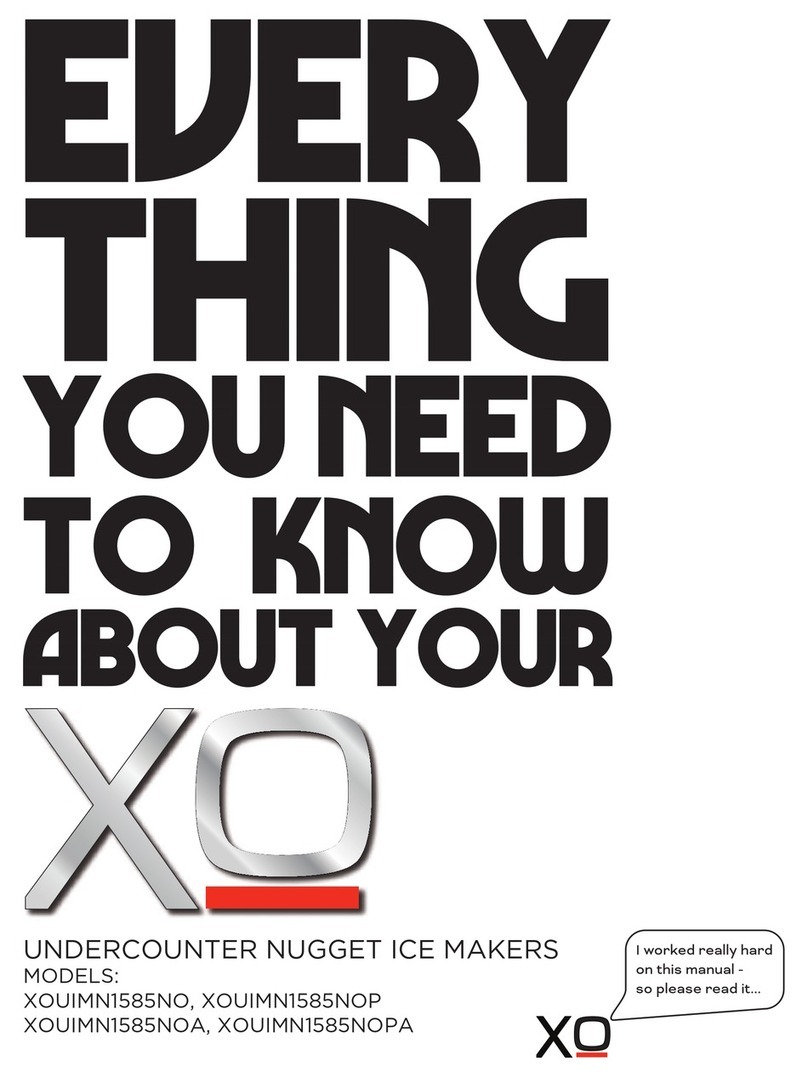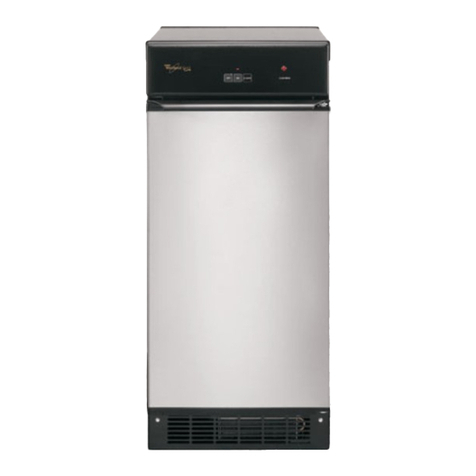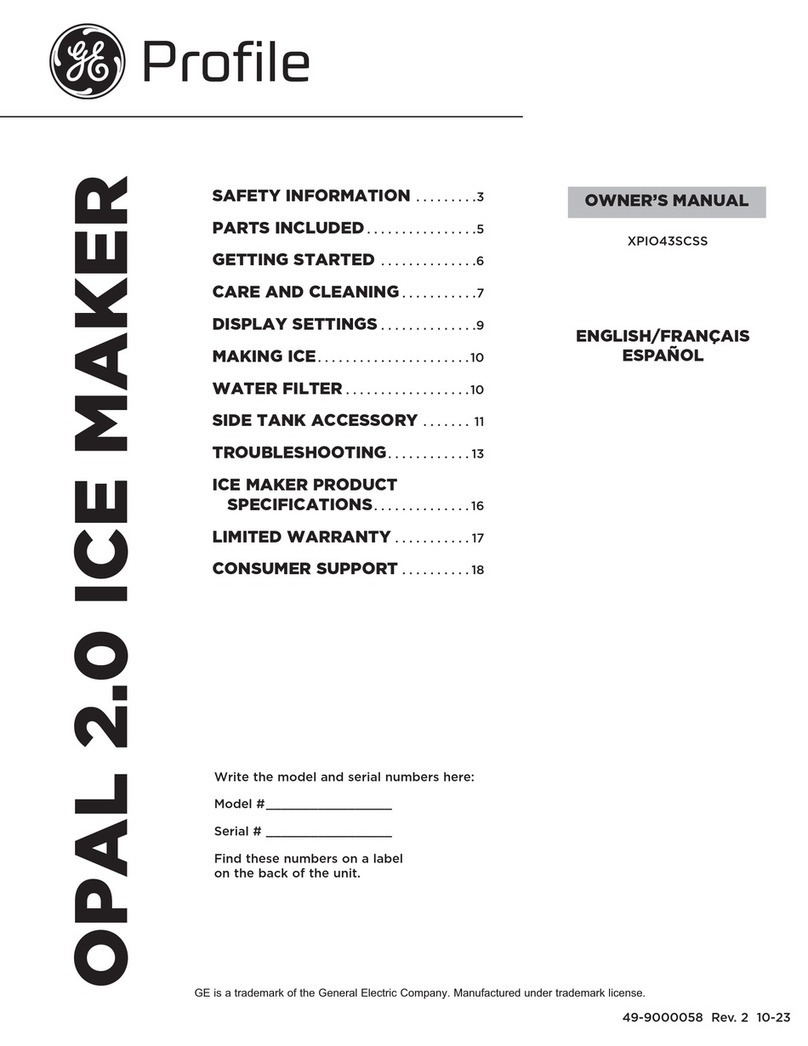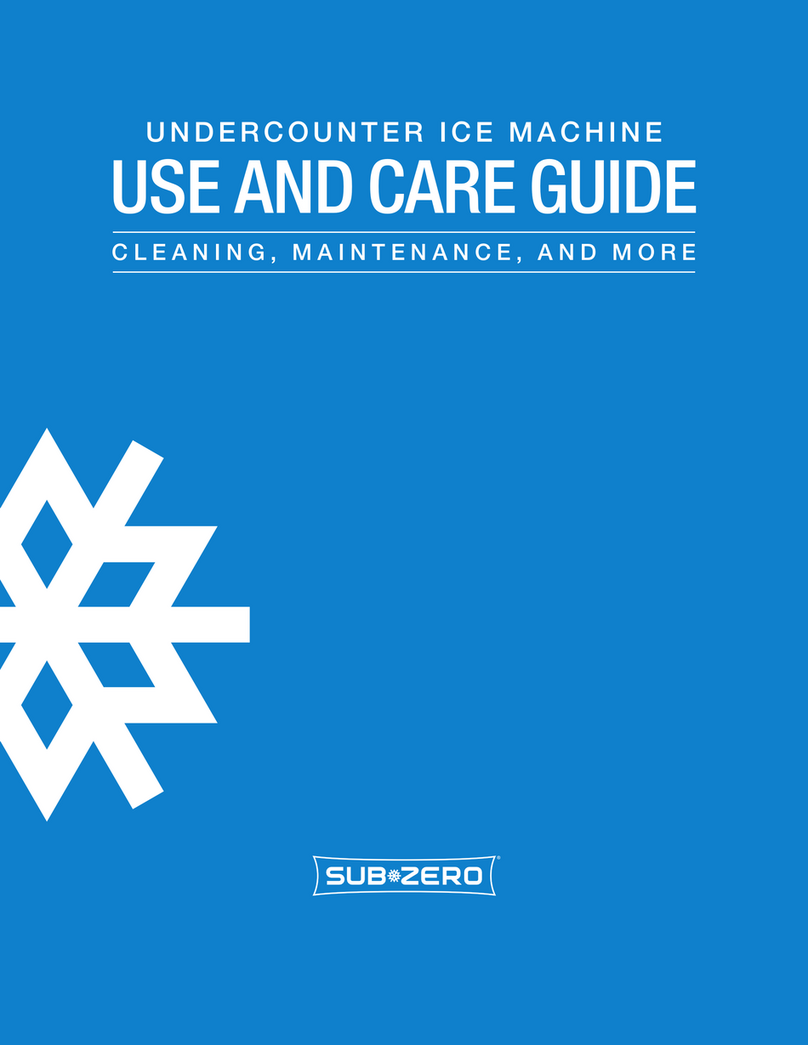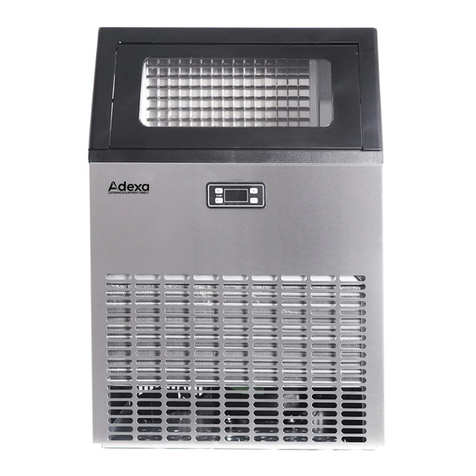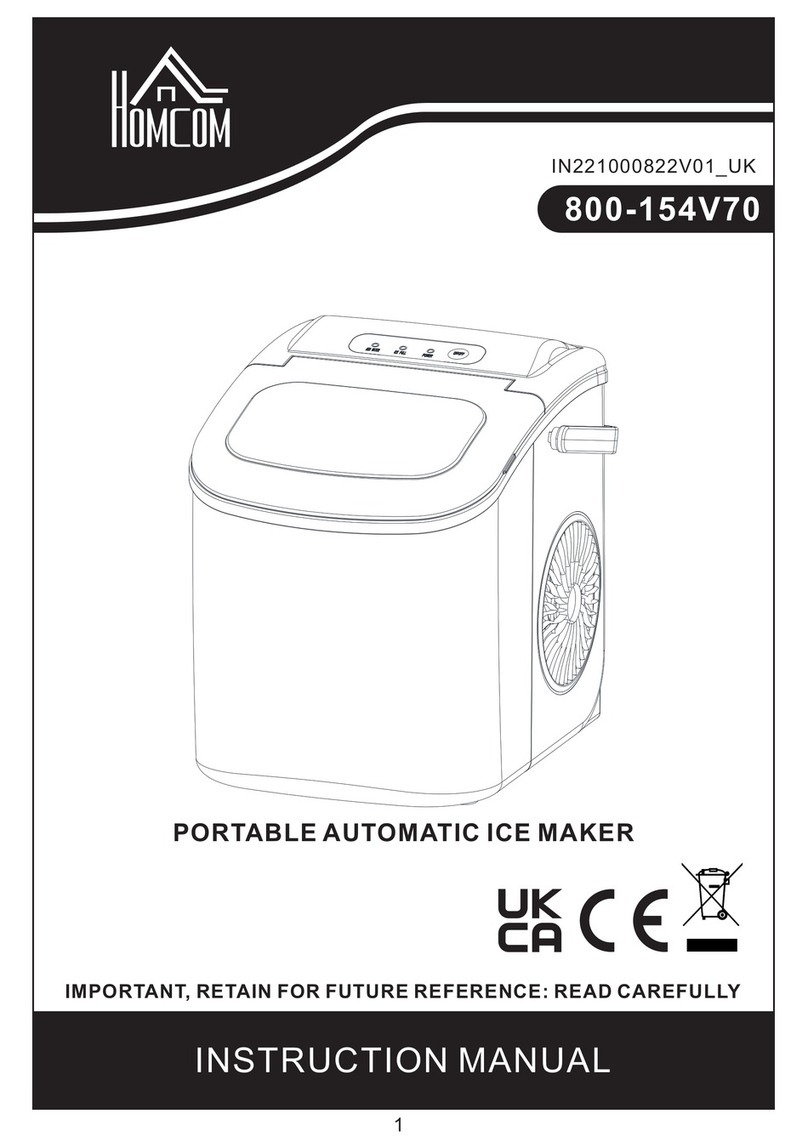SIMAG SD 10 User manual

Page 1
Page 1
SERVICE MANUAL
BEDIENUNGSANLEITUNG
SD 10
R 134 a
Home ice cuber
Kegeleisbereiter
090088.41 REV. 05/2001

Page 2
Page 2
INHALTSVERZEICHNIS SEITE
TABLE OF CONTENTS PAGE
TO THE USER 3
USER’S INFORMATIONS
- INTRODUCTION 4
DESCRIPTION
• Sealed Refrigeration System 4
• Self contained Storage Bin 4
• Removable water reservoir 4
SPECIFICATIONS 5
OPERATIONS BEFORE UNIT
START-UP 6
OPERATING INSTRUCTIONS
• Start-up 6
• Cleaning and Care 8
PRINCIPLE OF OPERATIONS
• Freezing cycle 10
• Harvest cycle 10
SERVICEMAN’S INFORMATIONS
- GENERAL 11
• Service Diagnosis 11
• Wiring Diagram 13
• Adjustment & Removal & Replacement
•Procedure 14
PARTS ILLUSTRATIONS AND
PARTS LIST ACCESSORIES 15
COMPRESSOR AND ELECTRIC
COMPONENTS CHART 19
FÜR DEN ANWENDER 20
INFORMATIONEN FÜR DEN ANWENDER
EINFÜHRUNG 21
BESCHREIBUNG
• Kühlsystem 21
• Eisbehälter 21
• Herausnehmbarer Wasserbehälter 21
TECHNISCHE SPEZIFIKATIONEN 22
VORGÄNGE VOR DEM
EINSCHALTEN 23
BETRIEBSANWEISUNGEN
• Einschalten 23
• Reinigung und Wartung 25
FUNKTIONSPRINZIP
• Gefrierzyklus 27
• Abtauzyklus 27
TECHNISCHE INFORMATIONEN
• Vorbemerkung 28
• Hilfe bei der Analyse 28
• Elektroschaltplan 30
• Entfernen und Auswechseln der einzelnen
Komponenten 31
ABBILDUNG UND LISTE DER
ERSATZTEILE 32
SD 10 - KOMPRESSORBAUTEILE UND
ELEKTRISCHE KOMPONENTEN 36

Page 3
Page 3
TO THE USER
YourmodelSD10IceMakerisaproductcarefully
engineered and quality constructed to provide
youwithmanyyearsoffaithfulperformanceand
a minimum of maintenance costs.
Produced by the world’s leading group of
automatic ice making equipments, your ICE
CUBE MAKER incorporates the same reliable
systems already proven over years of actual
operation by thousands of users. Many of you
will have an opportunity to see and use clear,
slow melting CUBERS for the first time.
You will quickly compare the clear, glass-like
quality of your Cubes to the type produced by
your home refrigerator, freezer.
By comparison, cubes made in trays in your
refrigerator are very white or cloudy, they also
melt faster than clear ice.
Takethetimenowtoreviewthismanualandyou
will see why these Cubes are solid and clearer
than ice cubes of your refrigerator.
No installation is required
Easyaccessforserviceisprovidedbytheprompt
removal of the front panel and/or the cabinet.

Page 4
Page 4
USER'S INFORMATIONS
INTRODUCTION
This manual provides the specifications and the
step-by-step procedures for the start-up and
operationand,themaintenanceandcleaningfor
the Model SD 10 Automatic Ice Cube Maker.
The SD 10 Automatic Cubers are quality desi-
gned,engineeredandconstructedandthroughly,
tested ice making and ice storage systems,
providing the utmost in flexibility to fit the needs
of particular users.
Separate sections detail more specifically:
General Informations & Start-up Operation;
PrinciplesofOperation;AdjustmentandRemoval
and Replacement Procedures; Maintenance &
CleaningInstructions;ServiceDiagnosis;Wiring
Diagrams; and the illustrated Assemblies, Parts
List & Accessories.
One of the outstanding features of this series of
cubers is the easy way for starting it up.
Sinceitdoesnotrequireanyplumbingconnection,
it can be placed in any location and put in
operation.
DESCRIPTION
An attractive compact cabinet of textured plastic
with an almond enamel finish, makes the styling
of the SD 10 very handsome allowing it to be in
harmony with many interior decors. The easy
removablefrontpanelprovidesimmediateaccess
to the water reservoir and to the electro-
mechanical components.
SEALED REFRIGERATION SYSTEM
Thecompressorisfullyhermeticanditsmotoris
internally spring-mounted to ensure quiet and
efficient operation of the Ice Maker.
Therefrigerantcircuitisentirelysealedtoprevent
mishandling and refrigerant leaks.
SELF CONTAINED STORAGE BIN
TheSD10ICEMAKERstoresitsownicesupply
in a properly insulated ice storage bin.
A sensing bulb of a thermostat keeps automatic
control of the stored ice cubes level.
A sliding (recessing) plastic door located in the
upper front of the cabinet gives ample access to
the storage bin.
REMOVABLE WATER RESERVOIR
ThemostexclusivefeatureoftheSD10consists
in having a removable water sump reservoir. It
can be easily removed at any time to be washed
clean.
A water level indicator is provided on the front of
thereservoirallovingpromptvisualinspectionof
water level into reservoir.
A special funnel in comunication with the water
reservoir allows prompt and easy filling of water
reservoir itself without the need to remove it.
∂
∑
∏
π
∫
bin recessing door
ice storage bin
water vessel
water level indicator
front panel
∂
∑
∏
π
∫

Page 5
Page 5
°C
°F
SPECIFICATIONS
NOTE.
When machine is “built-in” at ambient temperature of 32
°
C (90
°
F) indicated ice capacity
decreases about 10%.
To keep your HOME ICE CUBER performing at its maximum capacity, it is necessary to perform
periodic maintenance as outlined on page 7 of this manual.
• Dimensions =m/m380wide-380deep-640high
• Weight = 29 kg (64 Ibs.)
• Cabinet = Plastic
• Finish = Enamel
• Color = Almond
• Storage bin = ABS
• Door = Sliding (recess)
• Power Requirements = 230 Volts, 50 Hz, 1 Phase
• Power Consumption = 4,5 Kwh x 24 HRS
• Wire Size = 1 m/m
• Fuse Size = 6 Amps
• Compressor = 1/5 HP
• Refrigerant metering
device = Capillary
• Refrigerant Charge = 220 grms FREON, R 134 A
• Harvest Means = Hot gas
• Cubes per harvest = 8
• Storage bin capacity = 3.5 Kgs. (7.7 Ibs.)
• Water reservoir capacity = 4 liters (1.1 gl.)
11
10
9
8
7
6
5
Kg.
35 30 525 20 15 10
AMBIENT TEMPERATURE
ICE PRODUCED PER 24 HRS.
°C
o
AIR COOLED MODELS
2

Page 6
Page 6
OPERATING INSTRUCTIONS
START-UP
1) Locate on left side, in storage bin
compartment the funnel for pouring the water.
2) Through this funnel pour in unit water
reservoir 4 liters of fresh potable water.
3) Checktoseethroughthewaterlevelglass
the water level obtained. (Must not exceed the
maximumlevellineandnotbelowminimumlevel
line).
OPERATIONS TO PERFORM
BEFORE UNIT START-UP
1) Afterunpackingtheunit,visuallyinspect its
exterior and make sure it does not show any
severe damage.
2) Remove Lower Compartment Panel and
inspect for concealed damage; then check if fan
bladesmovefreely,andifcompressorissnugon
all mounting pads.
3) Open the bin door and remove any
wrappings or adhesive tape that may be inside,
as well as the instruction card attached to the
control knob.
4) Use clean damp cloth or disposable paper
wiper to wipe clean the interior surface of ice
storage bin.
5) Place ice maker in its selected permanent
locationandmakesurethatitisproperlylevelled.
NOTICE:
Priorconsiderationforlocationsite
shall include:
a) Minimum room temperature 10
°
C
(50 degrees F); and maximum room tempe-
rature 40
°
C (100 degrees F)
b) Well ventiled location for efficient air
removalaroundtheunitandmaintainproper
condensing operation.
c) Service Access i.e. adequate space for
prompt service inspections.
6) Check that the location source voltage
corresponds with the voltage specified on the
nameplate of the unit.
WARNING: The location power source
musthaveasolidearthwireconnection.

Page 7
Page 7
4) Plugtheelectriccableintotheappropriate
socket.Makesurethattheindicatoronthecontrol
knob is pointing to the “white dot”. The machine
is now working and the first cooling cycle can
begin.
5) The first freezing cycle will last about 35
minutes. During this time, make sure that the
plasticcurtainthatcoversthewaterspraysystem
hangs down loose and no excessive water is
passing through, make sure to eliminate
eventually noises and vibration sources.
6) After about 35 minutes of operation, the
first ice cubes harvest takes place.
7) Duringtheharvestcycle,whichlastsabout
3 minutes, the hot gas, circulating through the
evaporatorserpentine,defroststheicecubesup
tothepointthattheyarereleasedfromtheirmold
cups and drop into the storage bin.
8) If the tem-
perature of the
roominwhichthe
machine is place
isbelow20°C,the
cubeswilltendto
be partly hollo-
wed out (see fig.
on right).
If, on the other
hand, the room
temperature is
above 30°C the
cubes produced
willhaveajagged
rim of ice around
the crown.
9) If it is thought necessary, the above
situations can be remedied by, in the first case,
turning the control knob indicator (as little or as
much as is required) to the right of the white
markerand,inthesecondcase,turningtheknob
to the left. It should, however, be remembered
that if the room temperature returns later to the
20 ÷30°C range, the knob indicator must once
againbeturnedtopointtothewhitedot.(seefig.
below).
10) Theicemakerwillautomaticallystopwhen
the ice cubes in this storage bin compartment
cover the sensing bulb of the bin thermostat and
will automatically start when the same sensing
bulb will be cleared from the ice.
11) Remember to fill up the water reservoir
beforethewaterlevelinitgoesbelowtheminimum
level line of the indicator.
Inanycase,ifforsomereasonthemachineisleft
runningforashorttimewithoutwater,noserious
harm will be caused.

Page 8
Page 8
CLEANING AND CARE
WARNING - Before proceeding with
anycleaning operationmakesurethat
the power line of the unit is discon-
nected.
WATER RESERVOIR AND STORAGE
BIN LINER
All commercial units that make or contain edible
produces, require a frequent throught sanitation
of all their parts that are in contact with the
produces.
It is recommendable, therefore, to perform the
cleaninganddisinfectingoperationonceaweek
as per the following indications.
- Remove all ice cubes deposited in ice storage
bin if there are any.
-Remove the front lower panel by pulling it
from its upper edge and locate the water
reservoir.
Place one hand under the reservoir in order to
hold it and with the other grab the hooked front
edge.
- Slightly move the reservoir upward until it is
loose, than lower and tilt it a bit while
drawing out (try to avoid the pump body in
doing this).
- Make this reservoir empty and then place it
back in the unit.
- In a separate plastic pan, prepare a solution
with our rinsing - disinfectant P/N 264000 02.
- Pour the prepared solution into the storage bin
compartment than wipe clean its interior,
meanwhile the solution flows down into the
reservoir.
- Connectthepowerline andputinoperationthe
unitforfewminutes.Thebleachingsolution will
be circulated by the pump through the water
pipes and nozzles.
- Disconnect the power line, remove again the
plasticreservoir,makeitemptythenre-fititinits
place.
-Pourthroughthe funnel the necessary quantity
of new fresh water until the maximum water
level in the water reservoir is reached.
- The until is now sanitized and can resume
normal operations.
PUMP INLET SCREEN
While the water reservoir is removed, it is
recommendable to clean the water pump inlet
screen.
Pull it down with gentle pressure and wash it
clean under a stream of tap water. Once the
screen is properly cleaned reposition it in its
original place on the pump body.

Page 9
Page 9
AIR COOLED CONDENSER
It is very important to clean the condenser
regularly. A dirty or blocked condenser, will
drastically reduce ice production.
Use a vacuum cleaner to remove dust from the
front of the condenser.
CABINET EXTERIOR
Clean with warm water. Do not apply wax.
Note.
When cleaning the floor in the imme-
diate front the unit, try to do not move much
dust that could be easily sucked inside the
units through the panel louvers.
Eventually,forfewseconds,youcanplace
in front of the louvers a piece of paper or
cardboard to prevent that the brushed
dust panetrates into the machine
compartment.

Page 10
Page 10
WATER CIRCUIT
∏
π
∫
∂
∑
PRINCIPLE OF OPERATION
IntheSD10,the water to make iceiscontinually
movedorcirculatedbyasmallelectricpumpthat
sprays the water under gentle pressure through
the two spray jets into the eight inverted cube
molds.
Part of the water that hits the cold refrigerated
molds freezes, building gradually into full ice
cubes bell shaped.
FREEZING CYCLE (How it works)
Thehotgasrefrigerant,pumpedanddischarged
bythecompressor,passesthroughthecondenser
wherethefanblowingaircausesthechangingof
it into liquid.
The liquid line takes the refrigerant from the
condensertothecapillarytube.Duringthetravel
intothecapillarytube,theliquidrefrigerantlooses
gradually its temperature and pressure, then it
reaches the evaporator coils.
Because of the water sprayed against the
evaporator molds and coil, the liquid refrigerant
senses the heat of this water and starts boiling,
changing, as a consequence, from liquid into
vapor state.
The vapor refrigerant is sucked back to the
compressor through the suction line.
Thefreezingcycleiscontrolledbyatemperature
controlwhichdeterminesaswellthelengthofthe
cycle and consequently the size of the ice cube.
Duringthisphase,thecontactpointofthetempe-
rature control maintains closed the circuit of the
water pump which constantly sprays the water
under the evaporator mold cups up to the point
that the ice cubes reach their full size.
HARVEST CYCLE (How it works)
As soon as the temperature control senses the
temperature in the evaporator corresponding to
thefullsizecubes,thecontactmovestoclosethe
circuitoftheHotGasValveCoilandconsequently
to open the circuit of the water pump which
momentarily stops.
The hot gas refrigerant discharged by the
compressor is now diverted through the opened
hot gas valve to the evaporator coil.
The hot gas circulares through the evaporator
coil raising the temperature around the cube
cups sufficiently to release the ice cubes.
The released ice cubes drop by gravity into the
storage bin.
The temperature control bulb, due to the warm
temperature in the evaporator moves again the
contact de-energizing the hot gas valve and
energizing the water circulating pump starting a
new freezing cycle.
∑
❼
❾
HARVEST CYCLE
∏
π❻
Ω∫
∂
FREEZING CYCLE
∑
∏
π
∫
❻
∂
❼
Ω
❾
①EVAPORATOR
≠BIN
③SPRAY TUBE
④WATER PUMP
∞WATER RESERVOIR
①EVAPORATOR
≠ACCUMULATOR
③CAPILLARY TUBE
④SUCTION LINE
∞COMPRESSOR
±HOT GAS SOLENOID
±VALVE CLOSED
≤CONDENSER
≥FAN MOTOR
⑨DRIER
①EVAPORATOR
≠ACCUMULATOR
③CAPILLARY TUBE
④SUCTION LINE
∞COMPRESSOR
±HOT GAS SOLENOID
±VALVE OPENED
≤CONDENSER
≥FAN MOTOR
⑨DRIER

Page 11
Page 11
SERVICEMAN’S INFORMATIONS
GENERAL
Models SD 10 Ice Cube Makers have been
designed for little service and maintenance
requirements.
Average head pressure is 10 atm at the start-up
of the freezing cycle at 21°C ambient tem-
perature.
It gradually pulls down to 7 atm at the end of the
cycle.
Suction pressure at the start-up of the freezing
cycle will be around 3 atm then it pulls down
gradually to approximately 0 atm at the end of
freezing cycle.
SERVICE ANALYSIS
The following Service Analysis Section is for use in aiding the serviceman in diagnosing a particular
problem for pin-pointing the area in which the problem lies, thus an ever available reference for proper
corrective action.
SYMPTOM POSSIBLE CAUSE CORRECTION
Machine does not make ice. Fuse in Power Line Blown. Check fuses in the house fuse
box. Other loads on the same
line may have caused fuse
to blow. Use a 10 amp circuit
and fuse.
Water reservoir empty. Re-fill water reservoir.
Temp. control out of setting. Check for proper setting.
Wiring broken or connection off. Check electrical circuitry.
Compressor does not run. Any of the following may be
the cause. Starting relay,
overload, or defective compressor.
Water pump not operating. Clean or replace pump.
Bin thermostat not operating Check thermostat by warming
correctly. with hand and cooling with ice
cube. Replace if necessary.
Restricted Capillary Tube. Purge and recharge.
Moisture and air in system. Purge - recharge - replace drier.
Shortage of refrigerant. Charge unit properly.
Low ice capacity. High Room Temperature. Provide ventilation to the unit.
Decrease temperature as much
as possible.
High head pressure. Dirty condenser. Clean.
Cubes too large. Cube Size Control set Check and adjust for proper
improperly. operation.

Page 12
Page 12
Cubes cloudy. Spray jets Dirty. Clean.
Shortage of Water. Check water level in water
reservoir and re-fill.
Dirty water supply, accumulator Wipe clean water reservoir
of dirty in water system. and re-fill with new fresh water.
Clean water pump screen.
Cubes too small. Shortage of water. Check water level in reservoir.
Cube size control set Check and adjust for proper
improperly. operation.
Water leaking from pump Check clamp and hoses.
hoses. Replace if necessary.
Compressor cycles Low voltage. Minimum voltasge to be 10%
intermittently. Iess than normal rating.
Air in the system. Purge and recharge.
Poor harvest cycle. Too short defrost time. Check temperature control -
replace if necessary.
Hot gas not passing through Check hot gas valve coil,
valve. replace if necessary.
Shortage of refrigerant. Charge unit properly.
Ice cubes too big. Set control knob correct shape
of ice cubes.
SYMPTOM POSSIBLE CAUSE CORRECTION

Page 13
Page 13
WIRING DIAGRAM
THERMOSTAT
BIN. TEMP. CONTROL
2
4
6
62
4
MOTOR SOLENOID VALVE
FAN MOTOR
MOTOR COMPRESSOR
PUMP MOTOR
FAN MOTOR
A BLUE
M BROWN
N BLACK
G-V YELLOW-GREEN
PUMP MOTOR
BIN. TEMP. CONTROL THERMOSTAT
COMPRESSOR MOTOR
HOT SOLENOID VALVE

Page 14
Page 14
REMOVAL & REPLACEMENT PROCEDURE
WARNING: DISCONNECT THE ELEC-
TRICALSUPPLYBEFOREPERFORMING
ANY OF THE FOLLOWING OPERATIONS
Cabinet Removal
1. Remove lower panel by pulling forwand at
both top corners.
2. Remove water reservoir.
3. Disconnect the electrical cord and pass it
through the rear side of the cabinet into the unit
compartment.
4. Unloose and remove the two screws
secuting the front door trim to the side walls of
cabinet.
5. Through the interior of the compressor
compartment reach the three screws securing
the cabinet to the chassis and unloose them.
(See indicating arrows).
6. Remove the bottom drip tray.
7. Remove the cabinet by pulling it forward
from the rear side.
Temperature control replacement
(Evaporator)
1. Follow step 1 thru 7 for cabinet removal.
2. Removetemperaturecontrolknobbypulling
it.
3. Unloosethescrewsecuringthecontrolbox
panel.
4. Pull forward the control box panel.
5. Unloose and remove the nut securing the
temperature control to the panel.
6. Remove the spade connections from the
control.
7. Locatethethermostatbulbontheevaporator
and push it out from its well.
8. The control is now entirely removed.
9. Re-assemble the new control by
proceeding on reserve.
NOTE:
Seal both the ends of bulb holder
after the introduction of the new evaporator
thermostat capillary tube to avoid that some
water freezes inside.
Bin thermostat replacement
1. Follow step 1 thru 7 for cabinet removal.
2. Followstep1thru4fortemperaturecontrol
replacement.
3. Unloose and remove the nut securing the
bin control to the panel.
4. Remove the end of bin control capillary
tube from the interior of the bin.
5. Remove the spade connection from the
Temp. Control.
6. The control is now completely free.
Proceed to re-assemble acting on reserve.
Water pump Replacement
1. Follow step 1 thru 7 for cabinet removal.
2. Remove the screw which holds the water
pump in place.
3. Remove the two water pump electrical
leads.
4. Remove the hose from pump bottom
housing.
5. Lift out the pump.
6. To small the replacement pump, follow
previous steps in reverse.

Page 15
Page 15
THE PARTS ILLUSTRATIONS AND PARTS LIST
CONTROL PANEL ASSY
④
±
≤
≥
Pos. Part. N. Description
6 620264.10 Evaporator thermostat
7 660321.01 Panel
8 620263.00 Bin control

Page 16
Page 16
FRONT - VIEW
Pos. Part. N. Description
3 620433.00 Water pump assy
18 650330.00 Plug
22 660321.00 Control panel
24 784169.03 Curtain
25 660330.00 Funnel cover

Page 17
Page 17
SIDE - VIEW
Pos. Part. N. Description
44 784378.02 Evaporator cover
46 650361.05 Insulation
47 660326.05 Cabinet assy
49 660340.02 Evap. bulb holder
660386.00 Clip
50 783130.00 Evap housing
51 640093.00 Seal ring
52 660320.00 Water spray tray
53 610139.00 Plastic hose
(pump to spray system)
54 660336.00 Cover
57 660325.00 Water drip tray
58 781284.03 Bin door assy
59 782053.00 Ice storage bin
60 660339.00 Bulb holder
* Not shown
Pos. Part. N. Description
61 781285.04 Front lower panel assy
62 793114.00 Water reservoir assy
63 781335.00 Reservoir holder
65 784234.00 Evaporator platen assy
66 784252.02 Suction accumulator
67* 660359.00 Funnel insert
68 660335.00 Upper separator
69 660343.00 Lower separator
70 660338.00 Rubber fitting
71 660337.00 Sight glass
72* 783141.00 Reservoir cover
660424.00 Reservoir cover - Pump
73 660341.00 Rubber plug

Page 18
Page 18
Pos. Part. N. Description
8 620057.35 Relay for Cubigel
23 630003.05 Dryer
35 620285.00 Condenser
36 781283.00 Chassis assy
COMPRESSOR&CONDENSINGUNIT
Pos. Part. N. Description
1 670097.08 Compressor cpl. Cubigel
2 620306.48 Hot gas valve coil
620306.14 Hot gas valve body
3 620419.00 Fan motor only
7 620058.65 Protector for Cubigel

Page 19
Page 19
Compr. Compr. Start
relay protector Capacitor
SD 10-2 220/60/1 U.H. AE Z4425Y 670066.08 620057.40 620058.74 620167.45
SD 10-6 220/50/1 Cubigel GL 80PB 670097.08 620057.35 620058.65 –
Hot gas valve Hot gas valve Fan motor
coil body only
SD 10-2 620306.48 620306.14 620433.01 620419.00
SD 10-6 620306.48 620306.14 620433.00 620419.00
SD 10 - COMPRESSOR AND ELECTRIC COMPONENTS CHART
Model Volts Compr. Model Compr. Cpl.
Model Water pump

Page 20
Page 20
FÜR DEN ANWENDER
IhrEisbereiterModellSD10isteindurchdachtes
undsorgfältighergestelltesErzeugnis,dasIhnen
jahrelang beste Ergebnisse bei gleichzeitig
minimalen Betriebs- und Unterhaltskosten
garantieren wird.
Dieses Gerät wurde von einem der
bedeutendstenUnternehmensgruppenindiesem
Sektor,nachdemselbenPrinziphergestellt,das
bereits seit Jahrzehnten in Tausenden von
Geräten in der ganzen Welt erfolgreich zum
Einsatz kommt.
Viele von Ihnen werden wohl zum ersten Male
die Gelegenheit haben, Eiswürfel zu sehen und
anzuwenden, die sich durch außergewöhnliche
Festigkeit und Transparenz auszeichnen, und
die, was besonders wichtig ist, in einem
langsamen Prozess entstehen.
AlldieskönnenSiesonstvonherkömmlichen,im
HaushaltsgefrierschrankproduziertenEiswürfeln
nichterwarten,dieinderRegeltrübsindundsich
sehr schnell bilden
Wir möchten Ihnen vorschlagen, ein wenig Ihrer
Zeit der Lektüre dieses Handbuchs zu widmen.
So können Sie sich selbst davon überzeugen,
dass diese Eiswürfel sehr viel klarer und fester
sind als die Ihres Gefrierschranks.
Ein Wasseranschluss ist nicht erforderlich.
Wenn Sie die Vorderplatte und/oder das ganze
Gehäuse abnehmen, haben Sie leicht Zugang
zudeneinzelnenBestandteilendesEisbereiters
SD10.
Seite
This manual suits for next models
2
Table of contents
Languages:
Other SIMAG Ice Maker manuals
Popular Ice Maker manuals by other brands
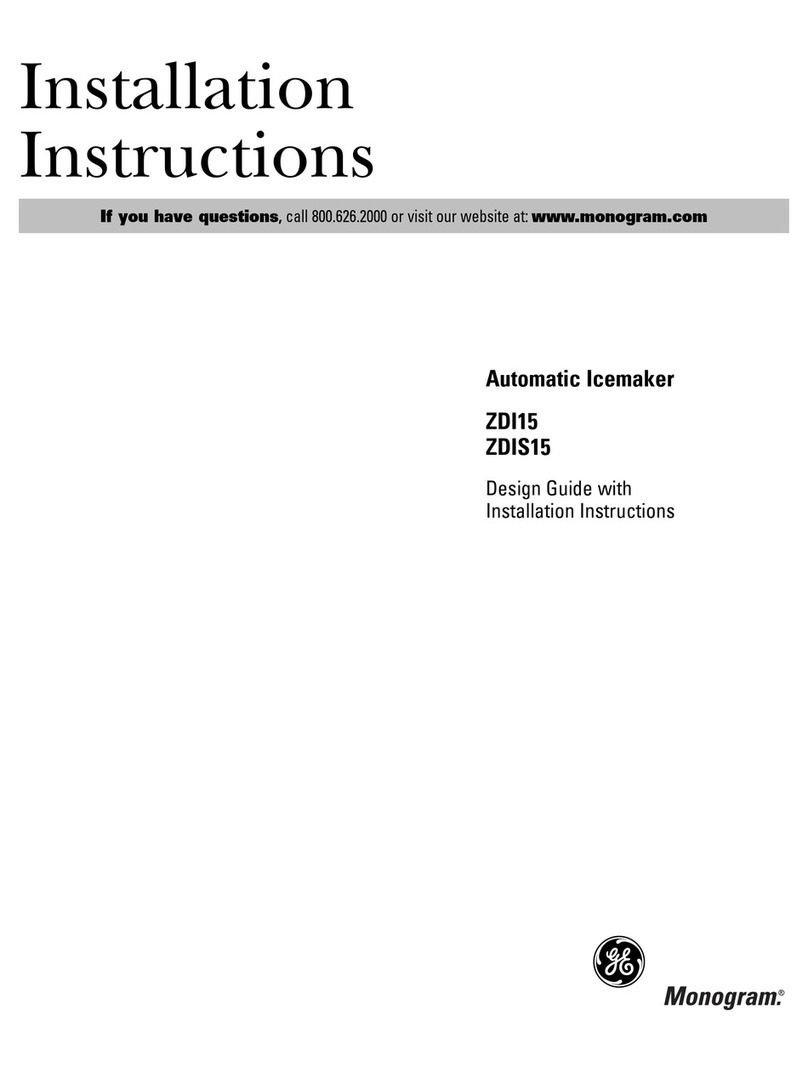
Monogram
Monogram ZDI15 installation instructions

Aquila
Aquila Pelletizer PE50 Original instruction manual
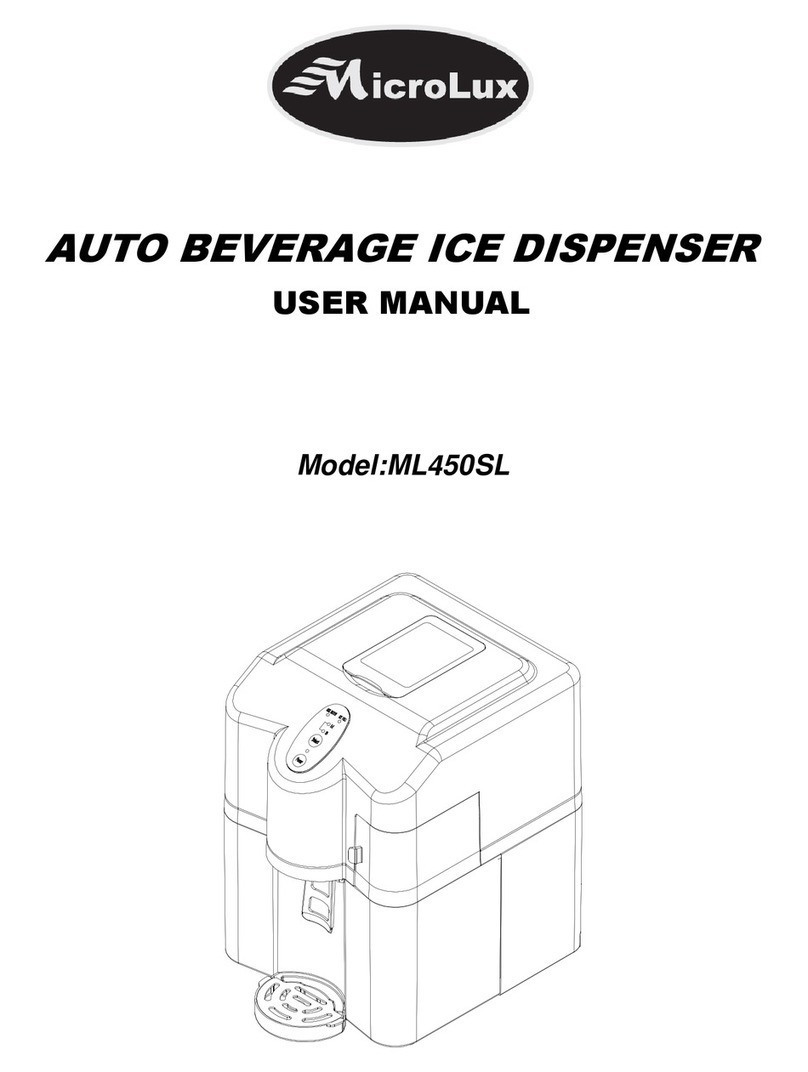
MicroLux
MicroLux ML450SL user manual
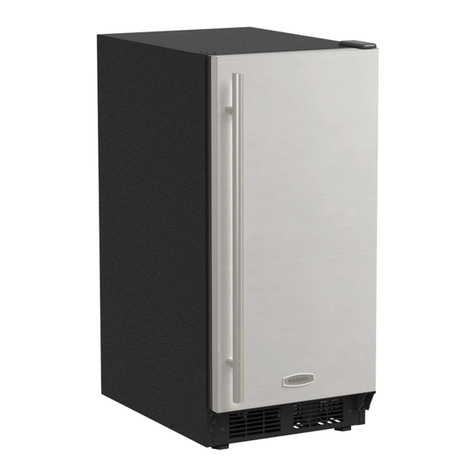
Marvel
Marvel MA15CRS1XS Installation, operation and maintenance instructions
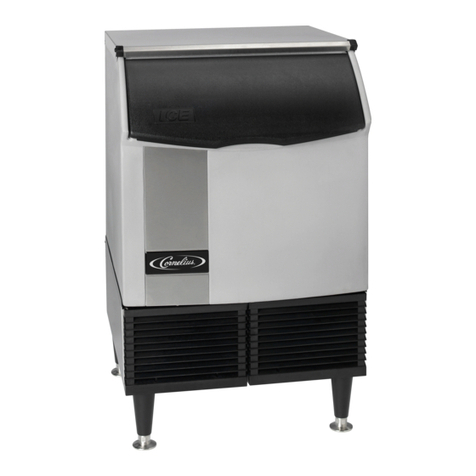
Cornelius
Cornelius CCM0330 Service and maintenance manual
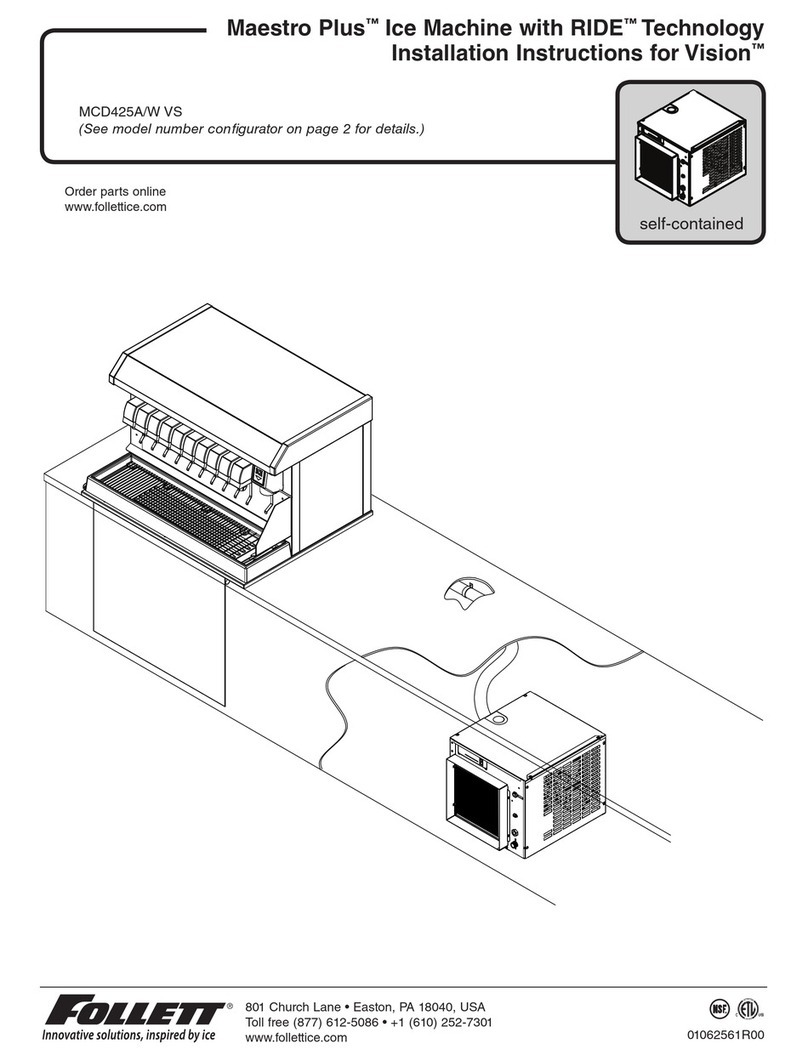
Follett
Follett Maestro Plus MCD425WBS installation instructions
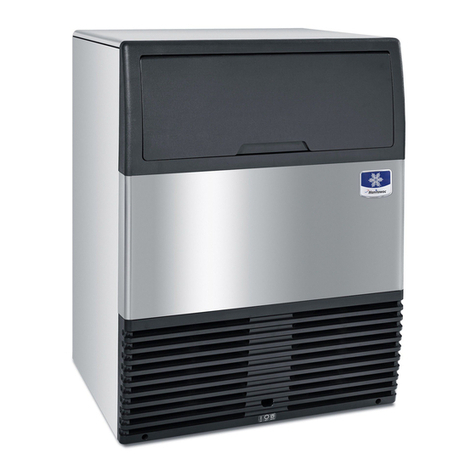
Manitowoc
Manitowoc UG Series Technician's handbook
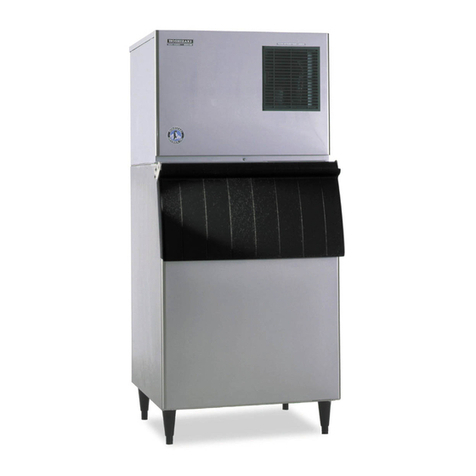
Hoshizaki
Hoshizaki KML-250MAH Cleaning & Sanitizing
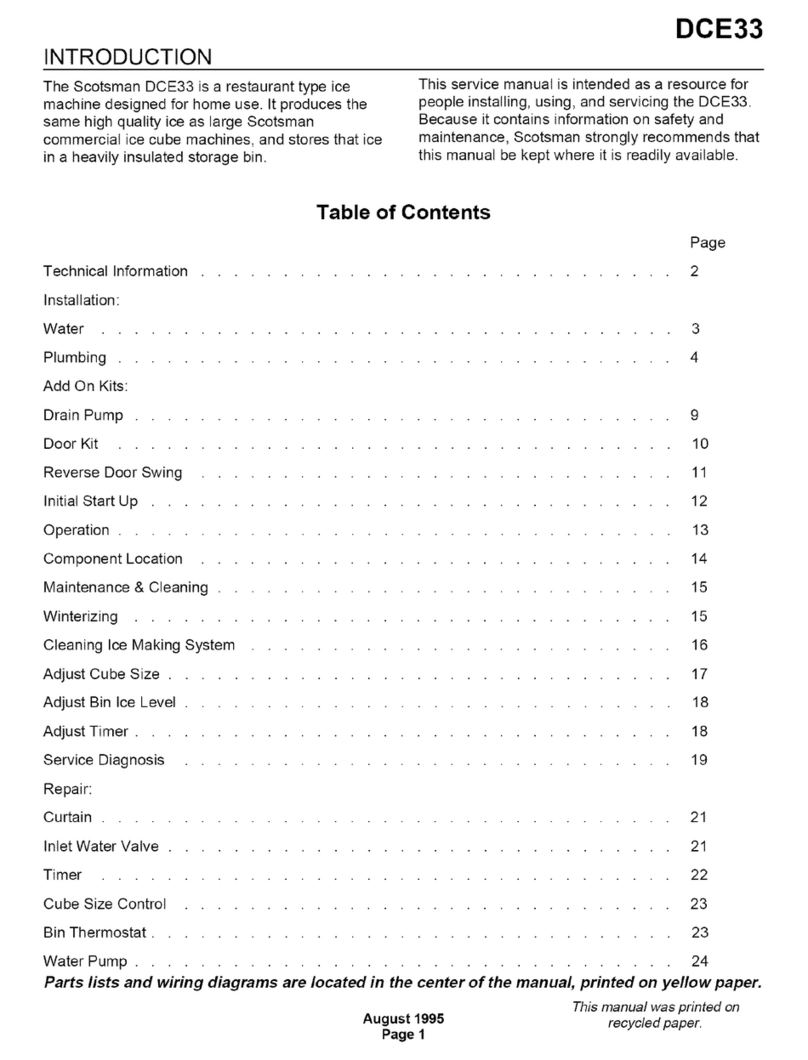
Scotsman
Scotsman DCE33 Series user manual

Metos
Metos Muster 350 User's installation and operation manual

Orien
Orien FS260IM user manual
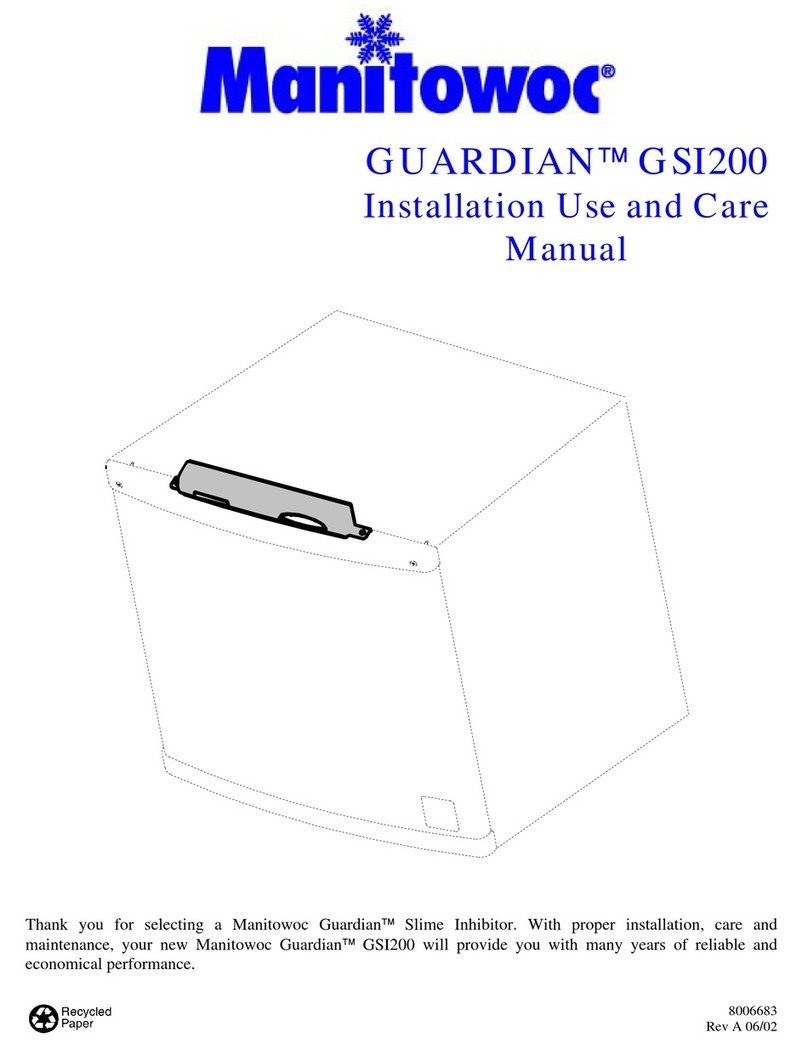
Manitowoc
Manitowoc GUARDIAN GSI200 Installation use and care manual
